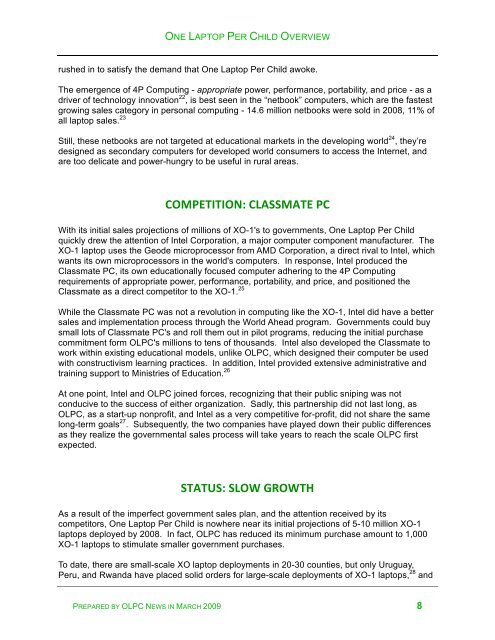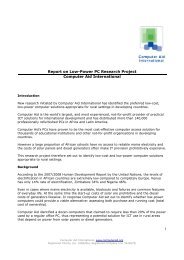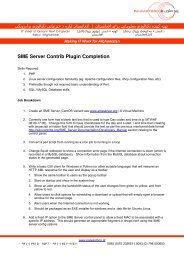ONE LAPTOP PER CHILD OVERVIEW - OLPC News
ONE LAPTOP PER CHILD OVERVIEW - OLPC News
ONE LAPTOP PER CHILD OVERVIEW - OLPC News
You also want an ePaper? Increase the reach of your titles
YUMPU automatically turns print PDFs into web optimized ePapers that Google loves.
<strong>ONE</strong> <strong>LAPTOP</strong> <strong>PER</strong> <strong>CHILD</strong> <strong>OVERVIEW</strong><br />
rushed in to satisfy the demand that One Laptop Per Child awoke.<br />
The emergence of 4P Computing - appropriate power, performance, portability, and price - as a<br />
driver of technology innovation 22 , is best seen in the “netbook” computers, which are the fastest<br />
growing sales category in personal computing - 14.6 million netbooks were sold in 2008, 11% of<br />
all laptop sales. 23<br />
Still, these netbooks are not targeted at educational markets in the developing world 24 , they’re<br />
designed as secondary computers for developed world consumers to access the Internet, and<br />
are too delicate and power-hungry to be useful in rural areas.<br />
COMPETITION:CLASSMATEPC<br />
With its initial sales projections of millions of XO-1's to governments, One Laptop Per Child<br />
quickly drew the attention of Intel Corporation, a major computer component manufacturer. The<br />
XO-1 laptop uses the Geode microprocessor from AMD Corporation, a direct rival to Intel, which<br />
wants its own microprocessors in the world's computers. In response, Intel produced the<br />
Classmate PC, its own educationally focused computer adhering to the 4P Computing<br />
requirements of appropriate power, performance, portability, and price, and positioned the<br />
Classmate as a direct competitor to the XO-1. 25<br />
While the Classmate PC was not a revolution in computing like the XO-1, Intel did have a better<br />
sales and implementation process through the World Ahead program. Governments could buy<br />
small lots of Classmate PC's and roll them out in pilot programs, reducing the initial purchase<br />
commitment form <strong>OLPC</strong>'s millions to tens of thousands. Intel also developed the Classmate to<br />
work within existing educational models, unlike <strong>OLPC</strong>, which designed their computer be used<br />
with constructivism learning practices. In addition, Intel provided extensive administrative and<br />
training support to Ministries of Education. 26<br />
At one point, Intel and <strong>OLPC</strong> joined forces, recognizing that their public sniping was not<br />
conducive to the success of either organization. Sadly, this partnership did not last long, as<br />
<strong>OLPC</strong>, as a start-up nonprofit, and Intel as a very competitive for-profit, did not share the same<br />
long-term goals 27 . Subsequently, the two companies have played down their public differences<br />
as they realize the governmental sales process will take years to reach the scale <strong>OLPC</strong> first<br />
expected.<br />
STATUS:SLOWGROWTH<br />
As a result of the imperfect government sales plan, and the attention received by its<br />
competitors, One Laptop Per Child is nowhere near its initial projections of 5-10 million XO-1<br />
laptops deployed by 2008. In fact, <strong>OLPC</strong> has reduced its minimum purchase amount to 1,000<br />
XO-1 laptops to stimulate smaller government purchases.<br />
To date, there are small-scale XO laptop deployments in 20-30 counties, but only Uruguay,<br />
Peru, and Rwanda have placed solid orders for large-scale deployments of XO-1 laptops, 28 and<br />
PREPARED BY <strong>OLPC</strong> NEWS IN MARCH 2009 8




